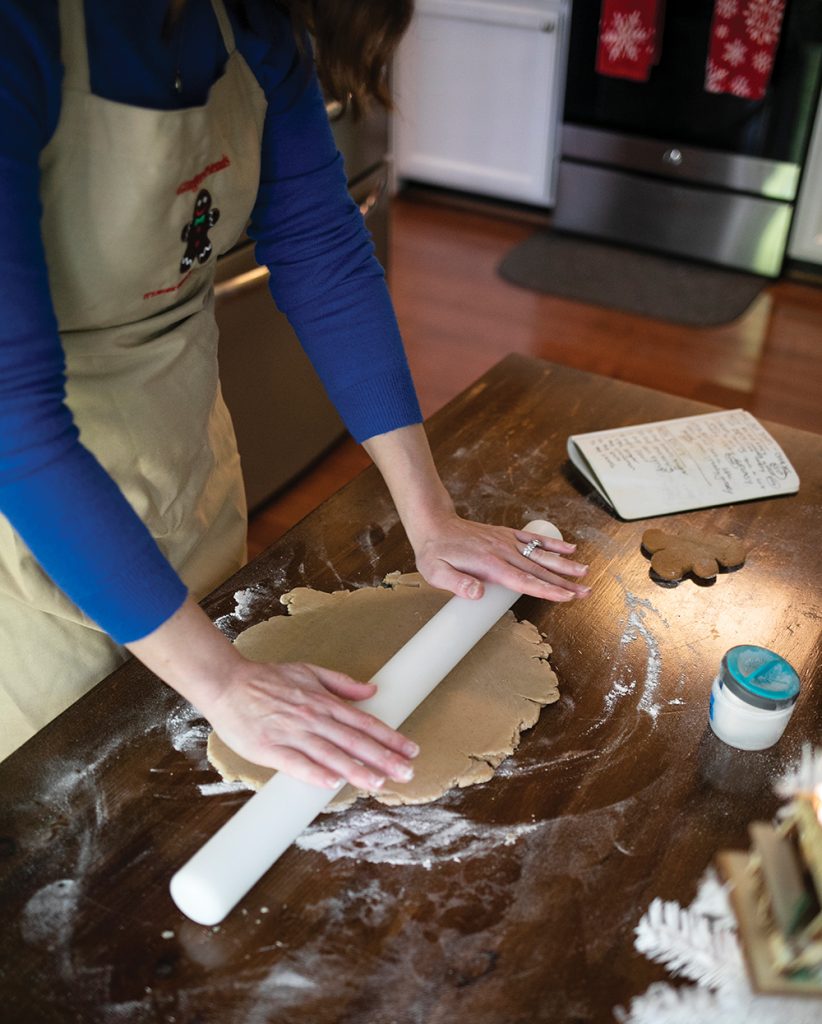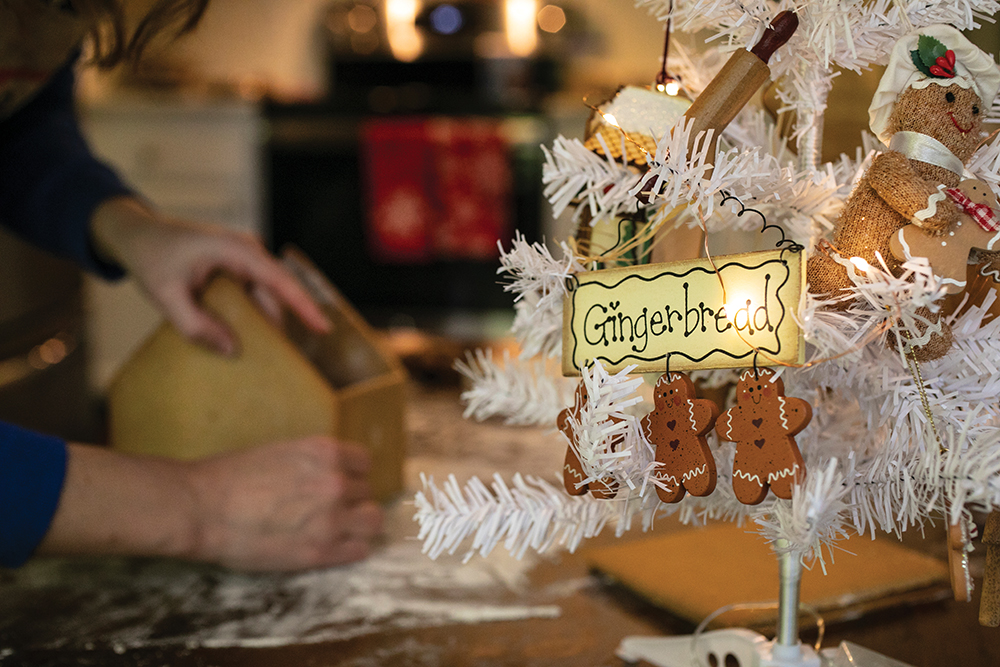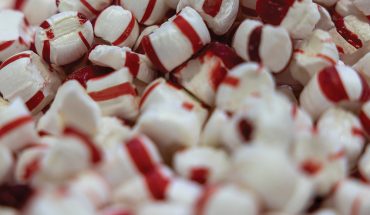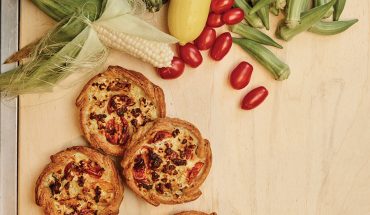Cary’s Grier Rubeling is an award-winning gingerbread crafter—here are a few of her must-haves for success.
by Lori D.R. Riggings | photography by S.P. Murray
Cary resident and Food Network finalist Grier Rubeling always carves out time before the holidays (and before competitions, too) to research, mix, make, modify, mold and munch a variety of gingerbread recipes. After tons of trial and error, she’s figured out which edible tools always come in handy. She’s also taken time to perfect various kinds of gingerbread recipes: one to make sturdy gingerbread that’ll taste good, another she calls “construction grade,” for houses that are more for display than eating. Read on for her must-have list and gingerbread recipes.

Grier Rubeling’s Gingerbread House Making Must-Haves
Every recipe requires a shopping trip for ingredients. Gingerbread houses are no exception, especially when it comes to designing gingerbread to tell a colorful story. Aside from the baking basics like flour and sugar, here are some other add-ons that Rubeling always keeps on hand.
- Powdered Sugar. “You can never have enough,” Rubeling writes, noting it’s the stuff royal icing is made of.
- Ice Cream Cones. Rubeling prefers sugar cones, writing they’re the; easiest way to make trees, and are perfect to be used for turrets and planters.
- Candy Canes. The “perfect” stand-in for columns, fence posts, and street lamps, Rubeling blogs.
- Sprinkles. Enough said, except, “I love the holiday themed ones,” Rubeling notes.
- Nuts. Rubeling likes roofs made of peanuts, pecans, almonds and slivered almonds.
- Pretzel Rods. In the gingerbread world, these can become logs, columns, firewood, sign posts. They can be used to help hold up structures.
- Graham Crackers. Just like our snacks, graham crackers “can be used for anything requiring a flat surface,” Rubeling writes. Think stairs, signs, decks, roofs. Like pretzels, they too can help hold your creations upright.

Delicious But Sturdy Gingerbread Recipe
Building a gingerbread house requires gingerbread that is sturdy, Rubeling said. She’s been using her yummy White House Gingerbread Recipe for years. In fact, she says, “It’s amazing!”
Ingredients
2 cups granulated sugar
1 cup & 2 tablespoons brown sugar
1 cup shortening
4 eggs
3 tablespoons molasses
1 1/2 teaspoons salt
2 teaspoons baking soda
1 tablespoon ginger
1 tablespoon cinnamon
6 cups flour
Directions
Combine the shortening and sugars with a stand mixer. Add eggs, one at a time, and beat until fluffy. Add the molasses, salt, baking soda, ginger, and cinnamon. Mix completely. Add the flour one cup at a time. The dough should be stiff, but not crumbling. If it starts to crumble, you can stop adding flour.
Roll out the gingerbread and cut your pieces out on parchment paper or a Silpat. Then just place a cookie sheet under it and bake for 10-14 minutes at 375 degrees. Bigger pieces take a little longer to bake than smaller ones. So I like to group them together by size to avoid burning. Once the edges turn a slightly darker brown, remove them from the oven and allow them to cool. “Then trim, cool, build, and decorate,” Rubeling said.
Grier Rubeling’s Construction-Grade Gingerbread
Rubeling also has an even sturdier and longer lasting gingerbread recipe—with fewer ingredients, too. Stripped of any rising or softening agents, it’s for building, not eating. “It’s consistent, easy, and versatile,” says Rubeling.
Ingredients
2 cups granulated sugar
1/2 cup honey
1 tablespoon water
4 eggs
2 teaspoons ground cinnamon
2 teaspoons ground cloves
2 tablespoons ground ginger
6 cups flour
Directions
Preheat oven to 325 degrees. Pour sugar into mixer. Heat honey in the microwave for 20-30 seconds, then pour onto sugar; mix until combined. Add water and eggs; mix until combined, scraping the sides as you go. Add ginger, cinnamon, and cloves; mix until combined, scraping the sides as you go. Add flour one cup at a time; mix until smooth. Switch your mixer to a dough hook and continue to mix.
Add more flour if needed, until the dough starts to separate itself from the sides of the bowl. Remove dough from bowl and put into a gallon ziplock bag. Refrigerate for an hour (optional but recommended. Flour the surface of a baking mat and start rolling the dough out (use a flour duster if it’s sticky). Roll until flat and cut out your gingerbread pieces. Bake the pieces for 15-20 minutes, rolling the dough once after 10 minutes.
When the pieces are firm, remove them from the oven, lay them on a flat surface, then put the pan on top of them so they cool nice and flat. Build and decorate!
Grier Rubeling’s Gingerbread Hacks and Fixes
- Mix should be easy to handle without much residue left behind on your hands. Too crumbly? Add water. Too wet and sticky? Add flour.
- Mix can be stored in a ziplock bag in the refrigerator until ready to use.
- The longer it stays in the fridge, and the more you handle it, the harder it will be to work with. It is easiest to roll out when fresh. However, it also tends to stick to surfaces more. Rubeling suggests a dusting pouch filled with flour to prevent sticking to surfaces.
- Bake-times vary according to the size and shape of gingerbread pieces. Rubeling suggests starting at 15 minutes if constructing walls, then monitor and adjust.
- The longer you bake gingerbread, the browner it will get.



